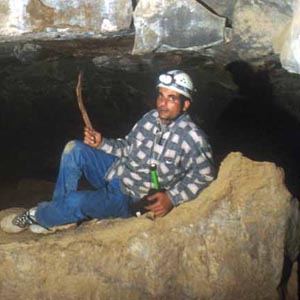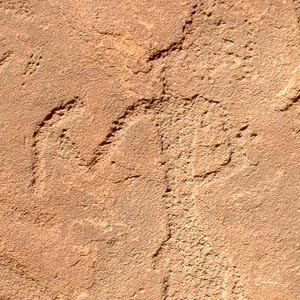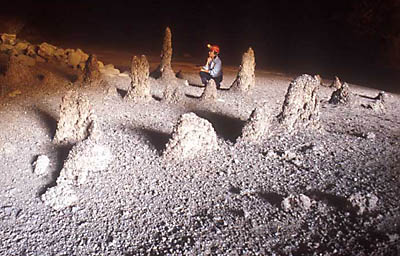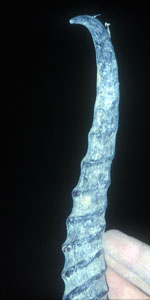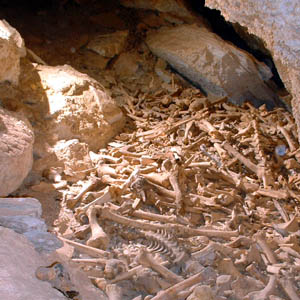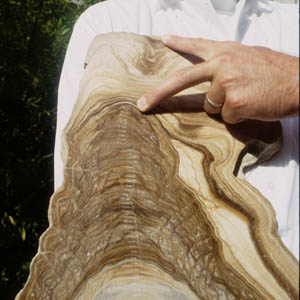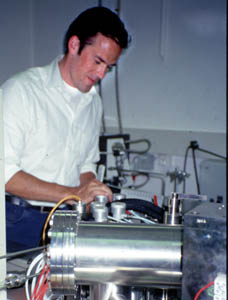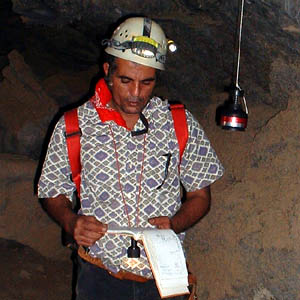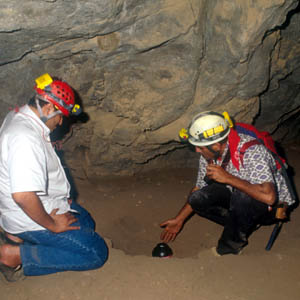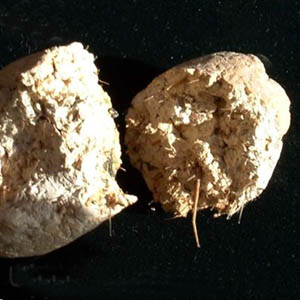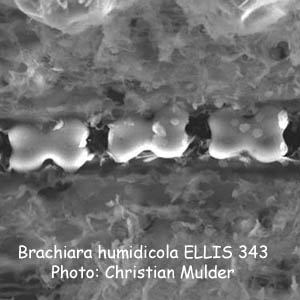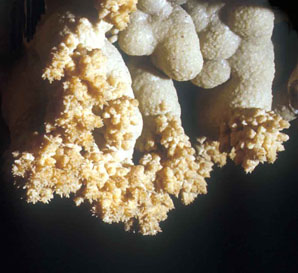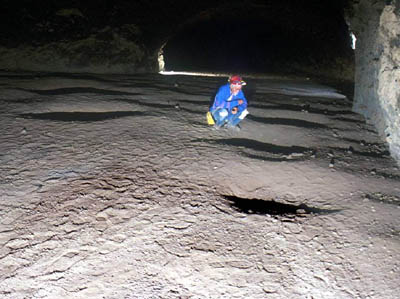








THE POTENTIAL
FOR SCIENTIFIC PROJECTS
IN SAUDI ARABIA’S CAVES
�2005 by John and Susana Pint, updated January 20. 2013
Photos by John Pint unless otherwise indicated
Very little was written about Saudi Arabia’s caves before 1983, even though its limestone beds and lava fields are dotted with thousands of holes leading to caves that were formed at least a million years ago.Today—with every new cave that is explored—it appears more and more likely that these desert caves may be hiding secrets of great interest to scientists working in many different fields. Web conferencing may be beneficial in coordinating further scientific expeditions. Consider, for example, the effect of low humidity on bones and artifacts lying inside a desert cave. In most cases, such items will be well preserved even though they are thousands of years old. Bearing in mind that the Middle East has been inhabited since the dawn of history, we are led to suspect that some vestiges of ancient civilizations may have found their way into the caves of Arabia, nicely preserved and just waiting to be discovered.
These speculations are somewhat supported by the discovery of various artifacts in Arabian caves during the last few years.
THE THROWING STICKS OF GHOSTLY CAVE
These flat, L-shaped
sticks were found in Ghostly Cave,
a lava tube in western Arabia. Although they are not boomerangs,
according to an expert, Dr. Martin Danks, they provide
aerodynamic lift when thrown inclined to the airflow and therefore
improve accuracy for hunting...
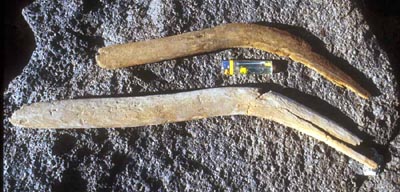
ANCIENT WALLS AND ARTIFACTS
Dahl
Murubbeh/B7 - This nicely folded animal skin was found near
skulls and bones deep inside this cave, which is located north of
Riyadh.
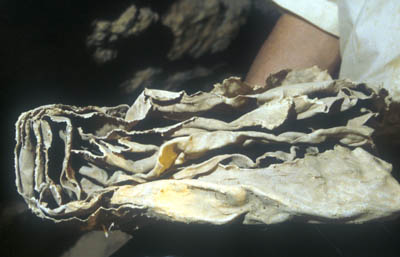
SKULLS AND MUMMIES
Two human skulls were found in Dahl Murubbeh and one in Ghar Al Hibashi, a lava tube located east of Jeddah. A complete human skeleton has not yet been found, but the well preserved, desiccated body of an Arabian Red Fox was located deep inside Murubbeh Cave. It should be noted that these various items were found lying on the cave floor. To date, no digging has been carried out in these caves.
 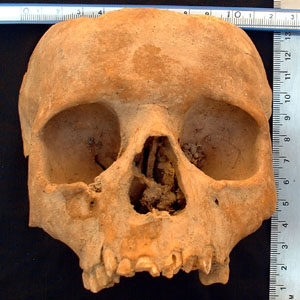
Left: Vulpus vulpus arabica, carbon-dated at 1900 years old.
Right: Skull of a young woman, carbon-dated at 425 years old; found in Hibashi Lava Tube.
|
BONES
Caches of bones, some containing thousands of items, have been found both in limestone and lava caves. Toothmarks on some bones were made by hyenas, according to experts in Austria, but animal scat suggests that foxes and wolves also inhabited these caves and may have carried bones inside...
|
...Large caches of bones are especially common in the caves of northern Arabia. No studies have been carried out on these bones, but it seems likely that they would yield information on past fauna. Left: Gazelle horn from Murubbeh Cave. Right: one of several caches of bones in Black Scorpion Cave described in a report on the Caves in the Habakah Region of the Kingdom of Saudi Arabia.
|
THE SECRETS OF STALAGMITES
Scientists can now learn a great deal about past weather patterns by looking inside stalagmites. As these formations slowly grow, they trap small bubbles of water. This water can be studied hundreds of thousands of years later. The isotopes of oxygen extracted from the water bubbles indicate whether rain conditions at the time of deposition were light or heavy. By age-dating each layer in a stalagmite, experts can determine the length of pluvial (rainy) periods in ancient times.
In 2002, scientists from Switzerland’s Bern University studied stalagmites collected from caves in several areas of Saudi Arabia. To their surprise, they discovered that most of these sample were far too old to be dated by the method they were using (which involves studying the decay of Uranium into Thorium). It was determined that stalactites and stalagmites in Saudi caves are over 400,000 years old and may even be as many as two million years old, according to a report published by the Saudi Geological Survey. This information may dramatically affect a wide variety of studies that were based on a much younger assumed age for Saudi cave formations.
|
Left: a stalagmite that has been sliced in half vertically. A dental drill is used to remove a small sample from every layer. Right: Dr. Dominick Fleitmann extracting oxygen from water trapped in a stalagmite.
|
Stalagmites from Oman, Yemen and Saudi Arabia were used for a study of the past effects of the Monsoon on the Arabian Peninsula]
SHRIMP IN THE DESERT?
Anyone who has examined a sample of water taken from a desert cave in Saudi Arabia can well understand why the Bedouin have been boiling that water for countless ages and disguising its taste with the strong flavors of coffee and cardamom. Cave water is often dirty, brackish and swimming with little creatures. In the mid-1980’s, biologist Dave Peters studied some of these creatures and found they were Anostracans, commonly known as Fairy Shrimp or Sea Monkeys (Anostracans in dark sections of Saudi Arabian caves by Denton Belk and Wm. David Peters). Scientists say their eggs will hatch after lying in the hot sand for fifteen years, but Bedouins insist those eggs will still hatch centuries later!
The durability of Fairy Shrimp eggs explain how they have managed to get into deep wells located “in the middle of nowhere,” apparently carried by the wind during sandstorms.
It is possible that some
of the Fairy Shrimp found in desert caves may belong to a previously
unidentified species. Very few biological studies have been carried out
in Saudi Arabia’s caves, so it is hoped that research into cave
microbes, insects, etc. will yield valuable results.
Fairy shrimp hatched
from eggs collected at the bottom of former water wells in Saudi Arabia.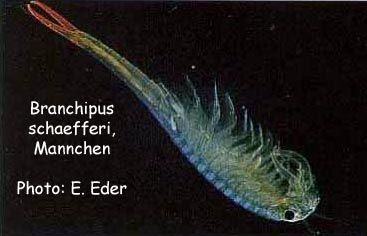
RADON GAS IN CAVES
Radon is the heaviest known gas. It is colorless, odorless and
tasteless at
normal temperatures. It is also radioactive and today it is the second
leading
cause of lung cancer in the United States (after smoking, of course).
Radon
comes from the natural radioactive breakdown of uranium in soil, rock
and spring
water. In some parts of the world, homes are regularly tested for radon
gas, but
testing for radon in caves is a relatively new idea. In particular,
little is
known about radon in volcanic caves.
In 2003, at the suggestion of Mr. Hisham Hashem of Saudi Geological Survey (and with his help), a project was begun to test for radon in some Saudi caves. At first, only short-term tests were carried out, and here are the results:
DAHL ROMAHAH, Harrat Khaybar (lava tube) Sept 17 03: 0 Pci/L (on floor) and 119 Pci/L (suspended in air)
KAHF AL SHUWAYMIS, Harrat Ithnayn (lava tube) Sept 17 03: 17.4 Pci/L (on floor) and 10.2 Pci/L (in air)
NAWARIAH MINE (abandoned mine N of Mecca) Oct 11 03: 196 Pci/L (in air)
HIBASHI CAVE, Harrat Buqum (lava tube) Nov 4 03: 25.6 Pci/L (on floor) 8.86 Pci/L (in air)
B 31 CAVE, As-Sulb Plateau (limestone cave) Feb 17, 2004: 1.2 Pci/L (in air)
|
Long-term radon testing devices are now in place in five other Saudi caves, all located in the Ma'aqala karst area..
Left and right: units for testing radon in the air and in the sediment of Kahf Al Shuwaymis Lava Tube.
|
BIZARRE MINERAL SOUP
Have you ever heard of Arcanite, Palygorskite or Whitlockite? These are just a few of the rare cave minerals [LINK} that have been found in Saudi Arabia’s caves... In fact, nineteen curious minerals were found in one cave alone (Hibashi Lava Tube). Since many interesting minerals were found in samples from only a handful of caves, it is likely this list will grow much longer if and when a systematic study is initiated. According to cave mineralogist Prof. Paolo Forti, some minerals found in samples from these caves have so far escaped identification, raising the possibility that at least one mineral entirely new to science may be hosted in one of the desert caves.
So many unusual
minerals were found in Hibashi Lava Tube, whose entrance is
shown on the right, that this cave has recently been added to the
official list of the ten most important lava tubes in the world (for
their mineral content). Many of these minerals were generated
with the help of dry bat guano which was set afire deep inside the cave.
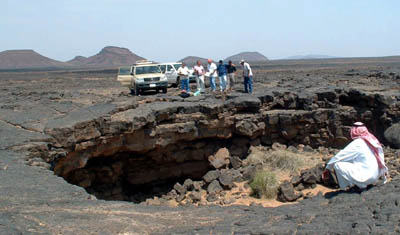
STONE SIGNATURES FROM ANCIENT PLANTS
Phytoliths are microscopic stones found in the leaves and roots of plants. They are composed of opaline silica and survive after the plant is destroyed, for example, by burning. The phytoliths of each plant have a unique shape, making it possible for scientists to use them to identify exactly which plant they come from.
Recently, it was discovered that plant matter has been preserved in wolf, hyena and fox scat, frequently found in Saudi Arabia’s desert caves. These animals, like dogs, apparently eat “grass” or other plants to aid in digestion. In one cave, such scat was found at the bottom of a sediment layer 6,000 years old (see below). The well preserved plant fiber in cave scat will allow scientists to study the ancient flora of the Arabian peninsula and phenomena such as desertification and wind patterns.
|
Left: Plant fibers in hyena scat taken from Mut’eb Cave (a lava tube in Harrat Kishb in western Saudi Arabia).
Right: Phytoliths are tiny stones found in plants. For more on phytoliths, see Christian Mulder's website.
|
THE GEOLOGY OF SAUDI ARABIA'S CAVES
In 1986, the Austrian Academy of Sciences (Gratz) and the University of Petroleum and Minerals (Dhahran) began a joint study of the caves near Ma'aqala and Shawiah on the As Sulb Plateau, north of Riyadh. Detailed maps and speleological descriptions of the caves followed, as well as important information on the role of these caves for recharging the country's most important aquifer during heavy rain storms.
Reconnaissance carried out after the year 2000 by the Pints and members of the Saudi Geological Survey turned up limestone caves in vast areas of northern Saudi Arabia. Geologically, these caves have characteristics different from those on the As Sulb Plateau and merit in-depth study of the sort carried out by the UPM-Austrian team. In 2001, a search was launched for lava caves in several of Saudi Arabia's lava fields. In each case, caves were found. Since only a few locations were checked (out of a huge area of 89,000 square kilometers of lava fields), it is thought that a great many more lava caves will be discovered in the future. Preliminary reports on the lava caves of Harrat Kishb have been published, but, again, in-depth research on the nature of these caves and how they were formed, needs to be carried out.
It also seems important to continue the hydrogeological studies undertaken by the UPM-Austrian team, due to the danger of pollution of the Umm-Er-Radhuma aquifer through caves recently made accessible to the public by the building of roads into karst areas. It should be noted that some caves, such as Ain Hit, allow hydrogeologists to study the aquifer "from the inside." (See Ain Hit I and Ain Hit II.)
|
In-depth geological studies of caves in the northern limestone and western lava fields of Saudi Arabia can be expected to yield valuable results. Left: Calcite formations in a lava tube (Romahah Cave). Right: These curious formations in That's-a-Good-Name Cave, located south of the border with Iraq, were probably formed completely under water.
|
THE DUST OF AGES
THE LAVA TUBES OF MARS
A joint project by the Field and Space Robotics Laboratory of MIT (Massachusetts Institute of Technology) and the Cave and Karst Studies Program at New Mexico Tech. (NM Institute of Mining and Technology) is using Hibashi Cave as a model for lava tubes on Mars. This project, funded by the NASA Institute for Advanced Concepts (NIAC) is looking at microrobotic technology for accessing such systems in extraterrestrial locations.
Mars has many lava tubes of great size. Because of the large amount of very fine surface material that is globally distributed on Mars by planet-scale dust storms occurring at fairly regular intervals, it has been hypothesized that such materials would sift into lava tubes and create a flat floor of such unconsolidated deposits...
...Saudi Arabia's
Hibashi cave is filled with such material and, according to Prof.
Penelope Boston of New Mexico Tech, presents a perfect
analog for such a situation. Research into "microbots"
capable of navigating in such an environment is
now being carried out by Prof. Boston's team and it is hoped that the
thick, dusty floor of Hibashi Cave will help to make the exploration of
Mars a success. Lava tubes on Mars
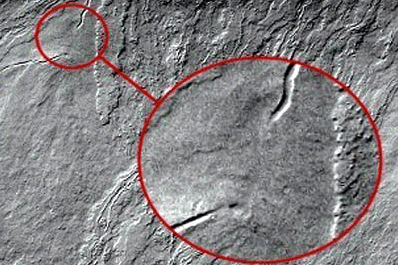
TECHNICAL REPORTS
More than eighty articles, reports and books on Speleology in Saudi Arabia are listed in the Bibliography section of this website...
... In addition, the
full text, tables, pictures and maps of all the Cave-related Reports of
the Saudi Geological Survey are downloadable from http://www.saudicaves.com/spspubs/index.html
. Cave reports published by Saudi Geological
Survey

We have listed just a few ideas for studies that could be made in the caves of Saudi Arabia. If you have comments or suggestions, please contact us. Your thoughts may launch a project in places where no scientist has gone before!
John Pint
